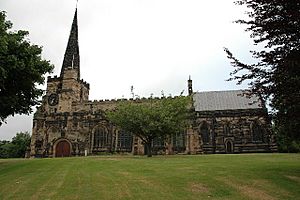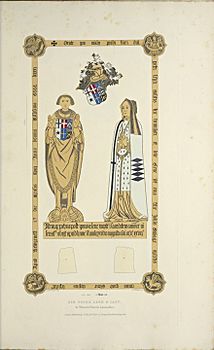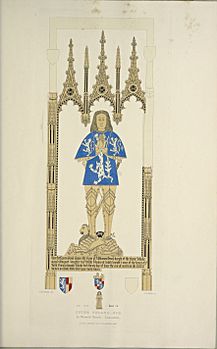St Oswald's Church, Winwick facts for kids
Quick facts for kids St Oswald's Church, Winwick |
|
|---|---|

St Oswald's Church, Winwick, from the south
|
|
| Lua error in Module:Location_map at line 420: attempt to index field 'wikibase' (a nil value). | |
| OS grid reference | SJ 604,928 |
| Location | Winwick, Cheshire |
| Country | England |
| Denomination | Anglican |
| Website | St Oswald's Winwick |
| History | |
| Status | Parish church |
| Dedication | St Oswald |
| Architecture | |
| Functional status | Active |
| Heritage designation | Grade I |
| Designated | 9 August 1966 |
| Architect(s) | A. W. N. Pugin (1847–49) Paley and Austin (1869) Henry Paley (1931–34) |
| Architectural type | Church |
| Style | Gothic, Gothic Revival |
| Completed | 1849 |
| Specifications | |
| Materials | Sandstone |
| Administration | |
| Parish | Winwick |
| Deanery | Winwick |
| Archdeaconry | Warrington |
| Diocese | Liverpool |
| Province | York |
St Oswald's Church is a very old and important church. It is located in the village of Winwick, Cheshire, England. This church is a special building because it is listed as a Grade I heritage site. This means it is one of the most important historical buildings in the country. Today, it is still an active Anglican parish church, part of the Diocese of Liverpool.
Contents
History of St Oswald's Church
A church in Winwick was first mentioned in the Domesday Book of 1086. This was a very long time ago! The oldest parts of the church you see today are from the early 1200s. These include the bases of the north arcade. The walls of the Legh Chapel and the organ chamber were built around 1330.
Building the Church Through the Years
The tall west tower was built in 1358. Most of the walls and the north arcade of the nave were built in 1580. In 1648, the church was damaged during the Battle of Red Bank. Oliver Cromwell's soldiers stayed in the church after the battle.
The south porch was added in 1720. In 1836, the south arcade of the nave was rebuilt using older stones. From 1847 to 1849, the chancel, sanctuary, and vestry were rebuilt. This work was done by a famous architect named Pugin. He worked for the 13th Earl of Derby.
In 1869, the church's spire was rebuilt. The church also had a big "Victorian restoration" by Paley and Austin. On January 13, 1887, Captain Edward Smith of the Titanic married Sarah Eleanor Pennington here. Later, in the 1930s, Henry Paley restored the tower and added new parts to the church.
Architecture and Design
St Oswald's Church is built from sandstone and has a metal roof. The church has a west tower and a long main area called a nave. It also has north and south aisles, a south porch, and two chapels. One chapel is the Legh Chapel, and the other belonged to the Gerard family.
Outside the Church
The tower has three sections and a spire that goes up high. On the west side, there is a door and a large window above it. Next to the window are statues of Saints Anthony and Oswald. You can even see a carved pig next to Saint Anthony! The tower also has clock faces and bell openings. The top of the tower has a crenellated (castle-like) edge.
The south wall was rebuilt in the early 1500s. A special message about St Oswald was carved into it in Latin. It talks about Oswald, a king who became a saint. It also mentions Sclater, who rebuilt the wall, and Henry Johnson, who was the curate at the time.
Inside the Church
The nave and aisles have beautiful oak roofs from 1711. The Legh Chapel has a special roof from the 1500s. Inside the Legh Chapel, there is a brass memorial for Sir Peter Legh and his wife Ellen from 1527. This is a unique memorial because it shows a "Knight and Priest" wearing church clothes over his armor, with his sword. There are also other memorials to the Legh family.
In the Gerard Chapel, you can find a damaged font from around 1400. There is also a brass memorial for Peter Gerard from 1495. Underneath this chapel is a family vault, but it has not been used since the Reformation.
At the east end of the church, there is a communion table from 1725. On the north wall, there is an aumbry, which is a small cupboard for sacred items. On a window-ledge in the Gerard Chapel, there is a piece of an Anglo-Saxon preaching cross from about 750 AD.
The pews, furniture, and stained glass in the chancel were designed by Pugin. A wooden screen was put up in 1920 between the nave and the tower. This screen is a memorial to those who served in the First World War.
The church organ was built around 1838 by Rushworth and Dreaper. They have added to it over the years. The church has a ring of six bells. Five of these bells were made in 1711, and the sixth was made in 1882.
Churchyard and St Oswald's Well
In the churchyard, there are special memorials for two soldiers from World War I. These were put there by the Commonwealth War Graves Commission.
About one mile north of the church, there is a special place called St Oswald's Well. It is in a field near the A573 road. This well is dedicated to St Oswald. It has medieval stonework and is covered by a stone slab. The well is a protected historical site.
More to Explore
- Grade I and II* listed buildings in Warrington
- Grade I listed churches in Cheshire
- Scheduled Monuments in Cheshire (1066–1539)
- Listed buildings in Winwick, Cheshire
- List of ecclesiastical works by Paley and Austin
- List of ecclesiastical works by Austin and Paley (1916–44)
See also
 In Spanish: Iglesia de San Oswald (Winwick) para niños
In Spanish: Iglesia de San Oswald (Winwick) para niños



